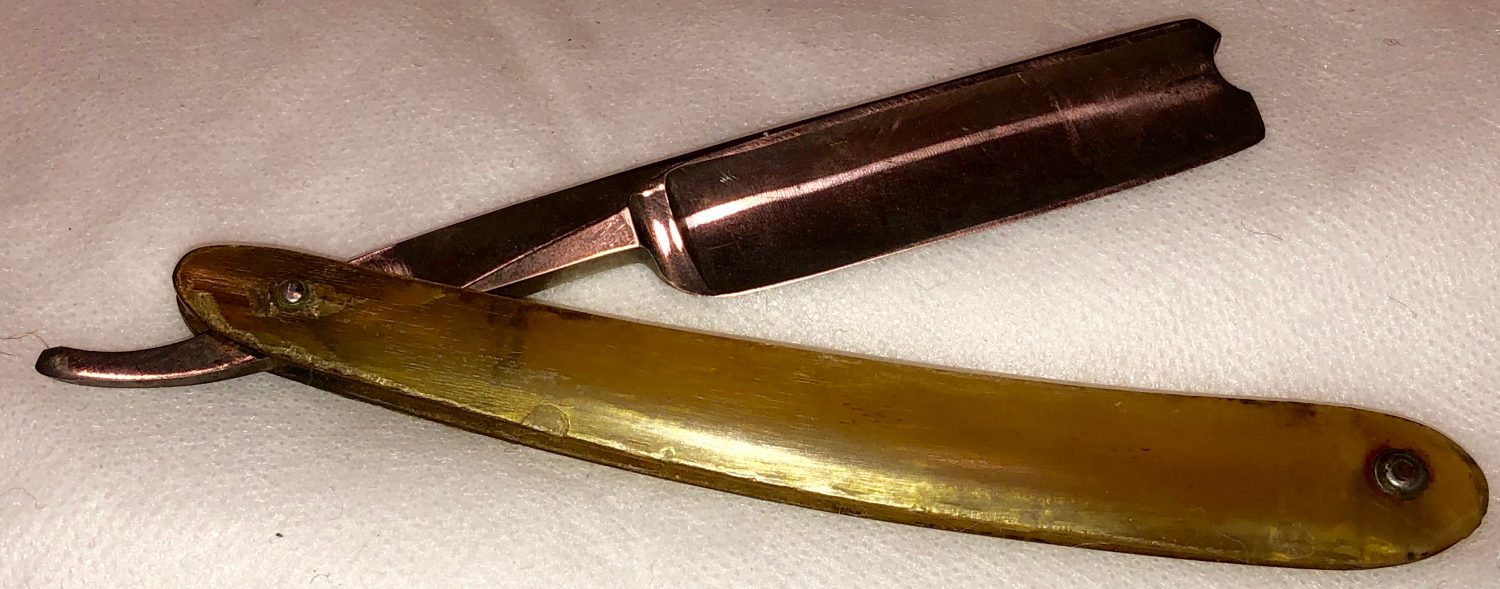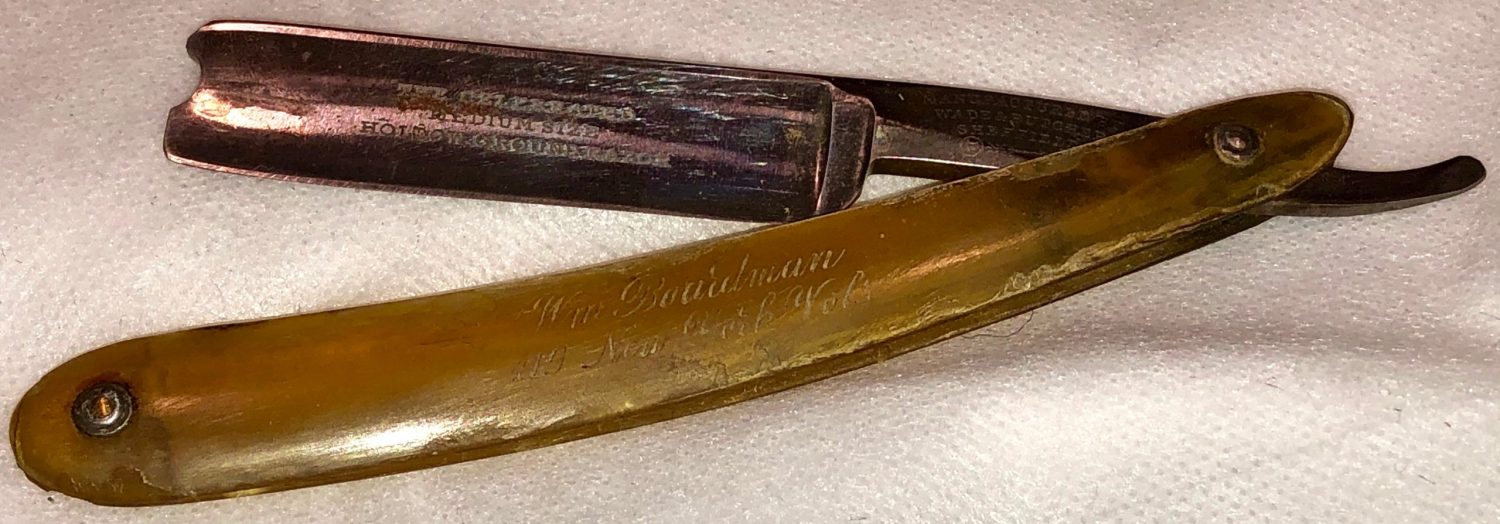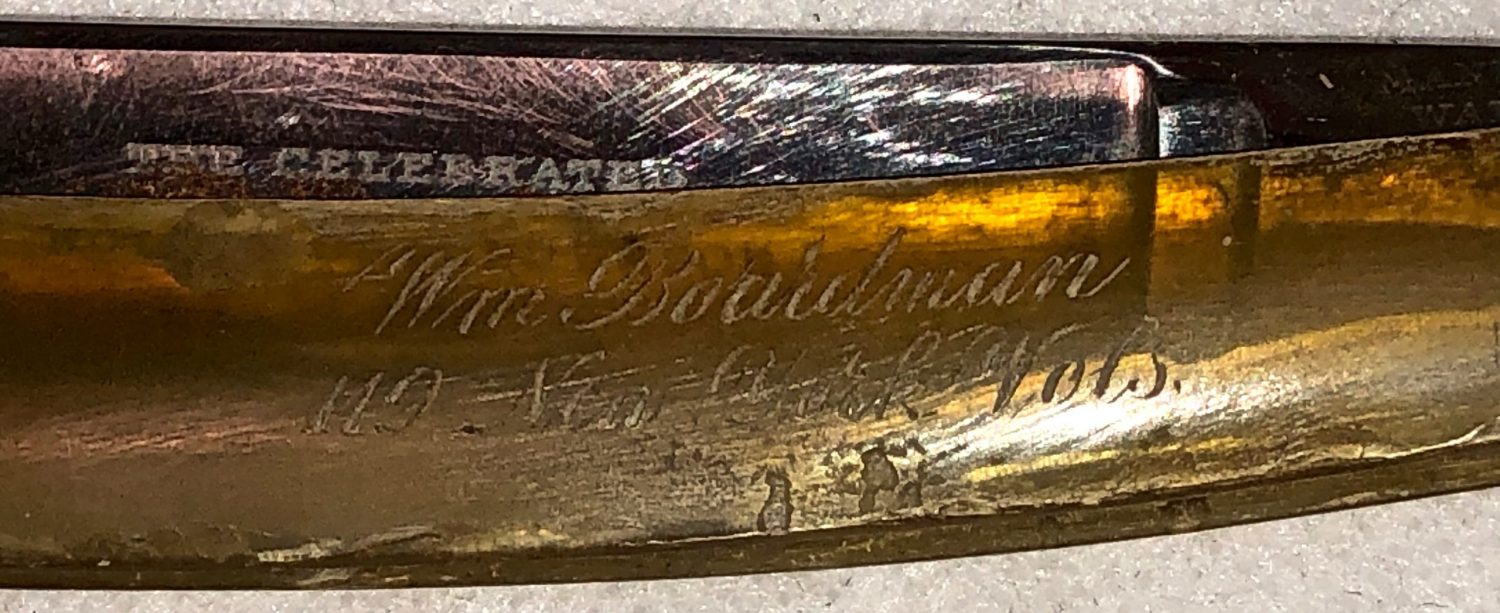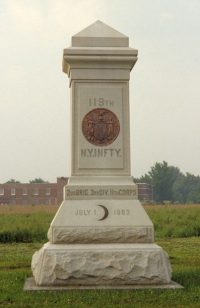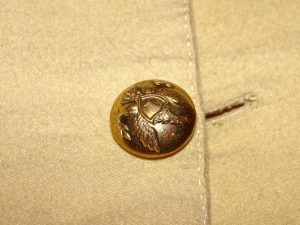Horn Handle Id’d Civil War Razor – WIA at Gettysburg
This fine example of a Civil War period razor has the following name and regimental ID engraved on one side of the horn handles:
“Wm. Boardman
119 New York Vols”
SOLD
Horn Handle Id’d Civil War Razor – WIA at Gettysburg – This fine example of a Civil War period razor has the following name and regimental ID engraved on one side of the horn handles:
“Wm. Boardman
119 New York Vols”
Engraved on the blade is: “THE CELEBRATED MEDIUM SIZE HOLLOW GROUND RAZOR”. The blade and handles remain in excellent condition.
Private Boardman enlisted in the 119th New York Infantry in June of 1862; he was wounded at Gettysburg on July 1, 1863. Boardman was discharged for disability, related to his wounding, in October of 1864.
William J. Boardman
| Residence was not listed; 33 years old. Enlisted on 6/7/1862 at New York City, NY as a Private. On 9/4/1862 he mustered into “A” Co. NY 119th Infantry He was discharged for disability on 10/3/1864 at Philadelphia, PA He was listed as: * Wounded 7/1/1863 Gettysburg, PA
BOARDMAN , WILLIAM J. — Age, 33 years. Enlisted, June 7, 1862, at New York city, to serve three years; mustered in as private, Co. A, September 4, 1862; wounded in action, July 1, 1863, at Gettysburg, Pa.; discharged for disability, October 3, 1864, at Philadelphia, Pa.
119th NY Infantry Organized: New York City, NY on 9/4/62 Officers Killed or Mortally Wounded: 6
|
|||||||||||||||||||||||||||||||||||
|
NEW YORK One Hundred and Nineteenth Infantry.-Cols., Elias Peissner, John T. Lockman; Lieut.-Cols., John T. Lockman, Edward F. Lloyd, Isaac P. Lockman; Majs., Harvey Baldwin, Jr., Benjamin A. Willis, Isaac P. Lockman, Charles F. Lewis, Chester H. Southworth. This regiment was recruited and organized at New York city in the summer of 1862, and was mustered into the U. S. service on Sept. 4-5, for three years. On the 6th the regiment left for Washington, where it was attached to the 2nd brigade, 3d (Schurz’) division, 11th corps (Howard), and went into winter quarters at Stafford, Va. At the battle of Chancellorsville, Howard’s corps was surprised and suffered severely, the 119th losing 21 killed, 67 wounded and 32 missing, Col. Peissner being killed while rallying his men. The regiment was commanded at Gettysburg by Col. Lockman, and was heavily engaged on the first two days of the battle, losing 140 in killed, wounded and missing. After returning with the army to Virginia, it was ordered with its corps on Sept. 24, to Tennessee. It was present but not active at the midnight battle of Wauhatchie, fought valiantly at Missionary ridge, and was then ordered with the corps to the relief of Knoxville, enduring severe hardships and privations during the campaign. In April, 1864, when the 11th corps was broken up, the regiment was assigned to the 2nd brigade, 2nd division, of the newly formed 20th corps, commanded by Gen. Hooker, the veteran Gen. Geary being in command of the division. It moved on the Atlanta campaign and took part in numerous battles in the next four months, including Rocky Face ridge, Resaca, where the brave Lieut.-Col. Lloyd was killed, New Hope Church, Kennesaw mountain, Peachtree creek, and the siege of Atlanta. After the fall of Atlanta, it remained with the corps to hold the city, while the rest of the army went in pursuit of Hood. On Nov. 15, the regiment moved with Sherman’s army on the grand march through Georgia to the sea and took part in the siege of Savannah, Geary’s division being the first to enter the city upon Hardee’s evacuation. Early in the year 1865, it moved on the campaign of the Carolinas fighting at Averasboro, Bentonville, Raleigh and Bennett’s house, but sustaining a loss of only 4 missing. After Gen. Johnston’s surrender, it marched on to Washington with the 20th corps, where it participated in the grand review, and was mustered out at Bladenburg, Md., June 7, 1865, commanded by Col. Lockman. The total enrollment of the regiment was 69 officers, 981 men. It lost by death during service, 6 officers and 71 men, killed and mortally wounded; 2 officers and 92 men by disease and other causes, a total of 171.
|
Late in the afternoon of September 5, 1862, the 119th New York Volunteers assembled outside regimental surgeon Dr. Charles Brueninghausen’s residence in New York City and received a stand of colors including the Regimental color seen here in the accompanying images. Made by Ball, Black & company of New York City, the embroidered color features the State Arms and the inscription, “5th SENATORIAL DISTRICT,” for the unit’s political home territory.
This flag accompanied the unit to Gettysburg, Pennsylvania, where, on July 1, 1863, the 119th New York Volunteers and other regiments from Brigadier General Wlademir Krzyzanowski’s brigade attempted to hold off the Confederate advance near Bloher’s Knoll. Outnumbered, the 119th New York Volunteers reportedly lost 100 men in 15 minutes, including two color bearers killed in action. The 13th Georgia Infantry captured the Regimental color .
The 13th Georgia retained the flag until the late 19th century when surviving Confederate veterans offered the flag to Benjamin Willis, a veteran who served with the 119th New York Volunteers at Gettysburg. Willis received the flag from the Georgia veterans, and in 1967, Willis’s daughter, Porta Willis Fitzgerald, turned the flag over to state authorities.


